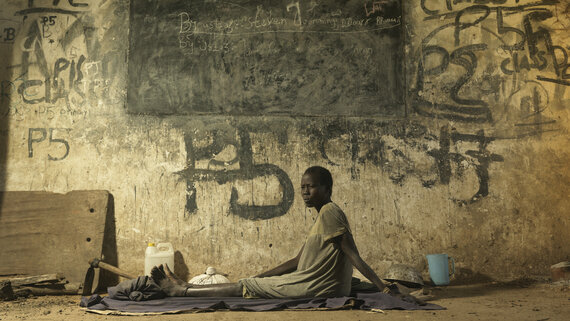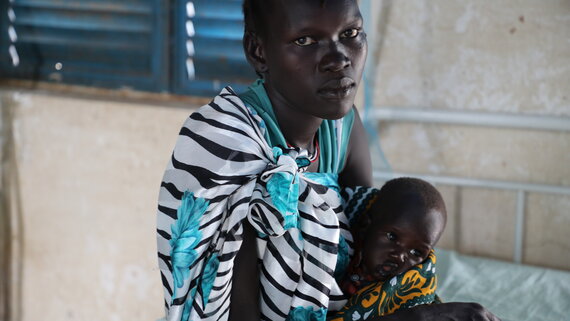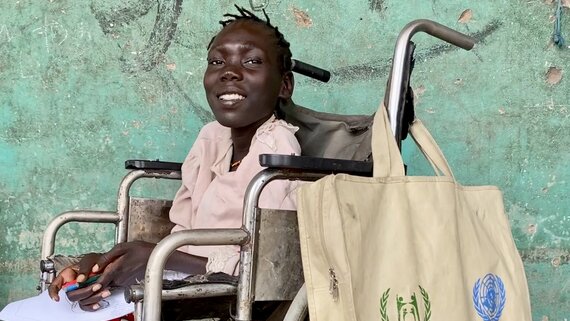Analysis of the context, crisis and needs
People in South Sudan continue to face the multiple compounding shocks of continued food insecurity, macroeconomic shocks, three consecutive years of flooding, disease outbreaks, increased sub-national violence, and threats and attacks on humanitarian workers and assets, resulting in an overall protection crisis. Implementation of the 2018 Revitalized Agreement on the Resolution of the Conflict in the Republic of South Sudan continues, albeit at a slow pace. Key benchmarks for the transition achieved in 2021 include the appointment of governors for all 10 states and the appointment of legislators for the national parliament. The remaining pre-transitional tasks include the critical formation and graduation of unified forces. The country has embarked on a constitution-making process, and democratic elections are slated to take place in 2023.
South Sudan is facing its highest levels of food insecurity and malnutrition since the country declared independence ten years ago. The Integrated Phase Classification (IPC) report released in December 2020 projected that an estimated 7.24 million people would face acute food insecurity from April to July 2021. Of these people, 108,000 were projected to be in IPC 5, 2.4 million in IPC 4 and 4.6 million in IPC 3. An estimated 1.4 million children under 5 years of age, the highest number since 2013, were expected to be acutely malnourished in 2021.
As of 19 November, an estimated 809,000 people were reported as affected by floods in 33 counties in eight states since May 2021. Jonglei, Unity and Upper Nile states are the worst affected. These three states account for more than 75 per cent of the total number of people affected. People’s livelihoods are being erroded as their livestock are decimated, homes, schools and crops are submerged. Flood-displaced people now sheltering in poor conditions are at risk of exposure to waterborne diseases. Some 100,000 people, mainly from Twic East, who were displaced by the 2020 floods, have not yet returned home as their lands remain underwater. Over two thirds of flood-affected counties were projected to face high levels of acute food insecurity this year, thereby exacerbating the dire humanitarian conditions of an already vulnerable people.

Old Fangak, South Sudan
A pregnant woman sleeps on the floor of a classroom in Old Fangak. Unrelenting floods from weeks of heavy rains swept away homes and inundated farmlands. Families and livestock have been forced to seek safety on higher ground and in neighbouring towns. The effects of the climate emergency are profoundly felt in East Africa. Communities, already struggling, are facing unprecedented floods and storms, unreliable rainfall, and the distress of hotter and drier conditions, as their basic needs and rights to water, food, livelihoods, land and a healthy environment are hit hard.
Action Against Hunger/Peter CatonThe Bentiu camp for internally displaced persons (IDPs) hosts some 108,000 displaced people. An alarming rise in Hepatitis E (HEV) prevalence and cases of acute watery diarrhoea was driven by a deteriorating water, sanitation and hygiene situation. As of 10 October 2021, a cumulative 1,309 HEV cases, including nine deaths, have been reported since 2019. HEV cases in the camp have risen to over 113 per cent from 2019 to 2020, and by 225 per cent from 2020 to date.
According to the WASH Severity Classification analysis (December 2020 – May 2021), WASH conditions in 51 of 78 counties were classified as phase 4, and 3 were classified as phase 5. The results of this analysis will likely drive an immediate response scale-up to address WASH needs.
Physical insecurity, bureaucratic impediments and threats against humanitarian workers and assets have increased in various counties. From January to September 2021, 415 access incidents were reported. Insecurity forced the relocation of 80 aid workers from Ayod and New Fangak counties in Jonglei State, Nagero and Tambura in Western Equatoria State, and the Greater Pibor Administrative Area. Aggressive and sometimes violent demands by youth for employment opportunities disrupted humanitarian operations in Torit, Renk, Koch, Ulang, Kapoeta, Jamjang, Gumuruk and Bentiu. During this period, four aid workers were killed in the line of duty and more than 200 aid workers were relocated from their areas of operation due to security threats. Between 8 July and 21 August, 312 metric tons of critical food items were looted in several parts of the country, affecting humanitarians’ ability to respond efficiently to people in need.

Pibor, South Sudan
A mother with her child at a stabilization centre for malnourished children in Pibor town, Greater Pibor Administrative Area.
OCHA/Htet Htet OoRepeated episodes of sub-national violence, such as in Tambura County in Western Equatoria State since June 2021, displaced an estimated 80,000 people. Killings of civilians, including men, women and children, abductions and conflict-related sexual violence allegedly perpetrated by armed men were reported, including forced recruitment in Tambura/Ezo targeting men and boys. Multiple testimonies from a protection report reflected high levels of violence included the targeting of civilians based on ethnicity and gender. Initial reports indicate that at least 200 people were killed. Witnesses and survivors report the rape of young women and girls by men in uniforms and civilian clothing with family members forced to witness.
Some 4 million South Sudanese people remain displaced due to conflict, insecurity and weather shocks. An estimated 1.7 million people are internally displaced and an additional 2.3 million South Sudanese are refugees in neighbouring countries. In addition, 91,000 South Sudanese refugees returned, predominantly from Sudan and Uganda, from January to end of September 2021.
Returns are also taking place in remote locations where there is limited infrastructure and access, an absence of housing, land and property, and protection risks that challenge peaceful coexistence with host communities.
Projected situation in 2022 and beyond
A continued deterioration of the humanitarian situation is expected, as needs are likely to increase. Factors likely to contribute to this include climate change and a forecast for continued rains into 2022, resulting in further flooding and more displacement. In addition, the country’s weak health system, low water supply coverage, poor hygiene and sanitation services, sub-national violence, reduced access as well as the limited humanitarian assistance footprint will continue to threaten an already vulnerable people.
WASH conditions are expected to worsen in 56 counties, remain the same in 14 counties, and improve in two counties. The forecast is primarily based on expected flood damage to existing WASH infrastructure during the wet season and the resulting increase in open-defecation practices, use of surface water for drinking, risk of disease outbreaks, and reduced humanitarian access for WASH actors due to insecurity and flooding.

Juba, South Sudan
Community focal points attend a training on gender-based violence (GBV) at the Women’s Union. GBV is one of the most critical threats to the protection and well-being of women and children in South Sudan. Many women and girls have experienced non-partner sexual violence, primarily during attacks or raids. The risk of child marriage remains constant due to conflict and the country’s economic situation.
UNICEF/Albert Gonzalez FarranSouth Sudanese women and girls are likely to face extreme levels of gender-based violence, exacerbated by armed conflict, organized violence and forced displacement due to flooding. Much of the violence goes underreported, with limited response services available to survivors. This creates conditions for conflict-related sexual violence and barriers for survivors to access gender-based violence response services due to ongoing violence in Tambura County.
Driven by a decline in oil and non-oil sectors and several concurrent shocks, including COVID-19, South Sudan’s GDP is expected to contract by 4 per cent in 2021.
Response priorities in 2022
The two-year 2022-2023 Humanitarian Response Plan (HRP) will be guided by three overarching strategic objectives addressing the three humanitarian conditions: physical and mental well-being, living standards and coping mechanisms. The multi-year plan will capitalize on the humanitarian-development-peace nexus efforts in the country and integrate disaster reduction and mitigation measures within programming. Humanitarian and protection needs, especially for women and children, continued to grow in South Sudan in 2021 and are expected to continue in 2022 as a result of recurring conflict and subsequent displacement, a climate emergency, an inability to reach health care and lack of access to schools.
Humanitarian organizations reached some 4.8 million people with humanitarian assistance and protection services by the end of September 2021. Key achievements include over 4.1 million people who received food assistance and livelihoods support; over 1.3 million people reached with healthcare; approximately 1 million people assisted with protection services; and some 1 million people provided access to safe water and sanitation. Over 930,000 children, pregnant and breastfeeding women were provided with emergency nutritional assistance; about 832,000 people received essential household items and emergency shelter. Some 720,000 people were reached through camp coordination and camp management services; and over 189,000 children were supported with access to education in emergencies.
South Sudan HRP
Humanitarian access challenges include operational interference, bureaucratic impediments, threats and violence against humanitarian personnel and assets and physical challenges caused by flooding. These challenges hampered humanitarian response to vulnerable people across the country. This year, Jonglei, Central and Western Equatoria experienced an upsurge in violence, affecting the delivery of humanitarian assistance to conflict- and flood-affected people. Humanitarian organizations reached half of their target population in these locations by the end of September. In Warrap State, where people were projected to face record levels of food insecurity during the lean season of May-July 2021, humanitarian organizations faced challenges to reach vulnerable people due to insecurity. Similarly, insecurity hampered the delivery of humanitarian assistance and services to the conflict-affected people in Tambura of Western Equatoria State, where some 80,000 people were displaced by conflict since June.
Since March, there has been a rise in the number of attacks against aid workers, people serving the community, and assets across South Sudan. Humanitarian warehouses and facilities were targeted during violence with humanitarian supplies looted, significantly impacting response operations in conflict-affected and food-insecure areas. Operational interference and threats by youth groups across the country have remained a challenge, leading to suspension of humanitarian activities, and increasing people’s vulnerability. Throughout 2021, youth groups continued to demand exclusive local employment with humanitarian organisation, and often shows aggressive, threatening stances to voice their demands. This behaviour led to the suspension of humanitarian activities and the relocation of workers from some locations. Negotiations between youth, local authorities, community leaders and the humanitarian community are ongoing to find a resolution. Between January and September 2021, more than 200 aid workers were relocated due to security threats.
As of 12 November, the 2021 South Sudan HRP was 64 per cent funded. Despite the relatively good funding received, humanitarian needs continue to grow, outstripping the available funding to respond in an effective and timely manner.

Pibor, South Sudan
This 13-year-old girl is determined to go to school despite the persistent violence and recurrent flooding. With funding from the South Sudan Humanitarian Fund, she has received psychosocial and other support.
OCHA/Emmi AntinojaAchievements and innovations
In the context of South Sudan, Accountability to affected populations (AAP) remains of paramount importance to the overall humanitarian response, propelled by the operational responsibilities to promote a rights-based approach and improve aid effectiveness across humanitarian programming. Recent demands and grievances expressed by youth led to significant interference in humanitarian operations in several locations. For those with legitimate concerns, investment has increased in AAP and engagement strategies with the community, including youth representatives, to hear their concerns, respond appropriately and sensitize about how humanitarian activities take place.
In 2021, cluster coordinators engaged in a strategic AAP workshop to review and seek opportunities to strengthen community engagement and participation, with the aim of ensuring that affected populations are at the centre of humanitarian action. The workshop outcomes informed the development of a Humanitarian Country Team (HCT) AAP strategy intended to solidify the HCT’s role when leading on AAP across the response. The HCT AAP strategy complements the Centrality of Protection and Gender in Equality Programming in Emergencies road maps. The HCT AAP strategy supports the operationalization of the Inter-Agency Standing Committee’s commitments on AAP and the prevention of sexual exploitation and abuse at the response level. It is guided by five strategic objectives:
- Oversight of senior leadership on key AAP issues.
- AAP is mainstreamed throughout the Humanitarian Programme Cycle to enable a community-centred response.
- Ensure decentralized leadership on AAP to State-level coordination mechanisms empowered to ensure AAP strategies are informed by local contexts.
- Collective mechanisms are developed at the response level for a coordinated approach to AAP
- Enhance the communications and community engagement and AAP capacity of national organizations and civil-society actors as well as their role within humanitarian decision-making.
Further reading
Source: OCHA
Source: Humanitarian Insight
Source: Financial Tracking Service
References
- South Sudan, IPC Acute Food Insecurity & Acute Malnutrition Analysis, 18 December 2020.
- OCHA South Sudan Humanitarian Snapshot, September 2021.
- South Sudan - Humanitarian Snapshot, March 2021
- South Sudan, Displacement Tracking Matrix, Quarter 2 Report, 2021. *The final validation of the multisectoral needs in sites and villages/neighbourhoods was in process as of the end of this reporting period and would cover more than 2,500 locations.



